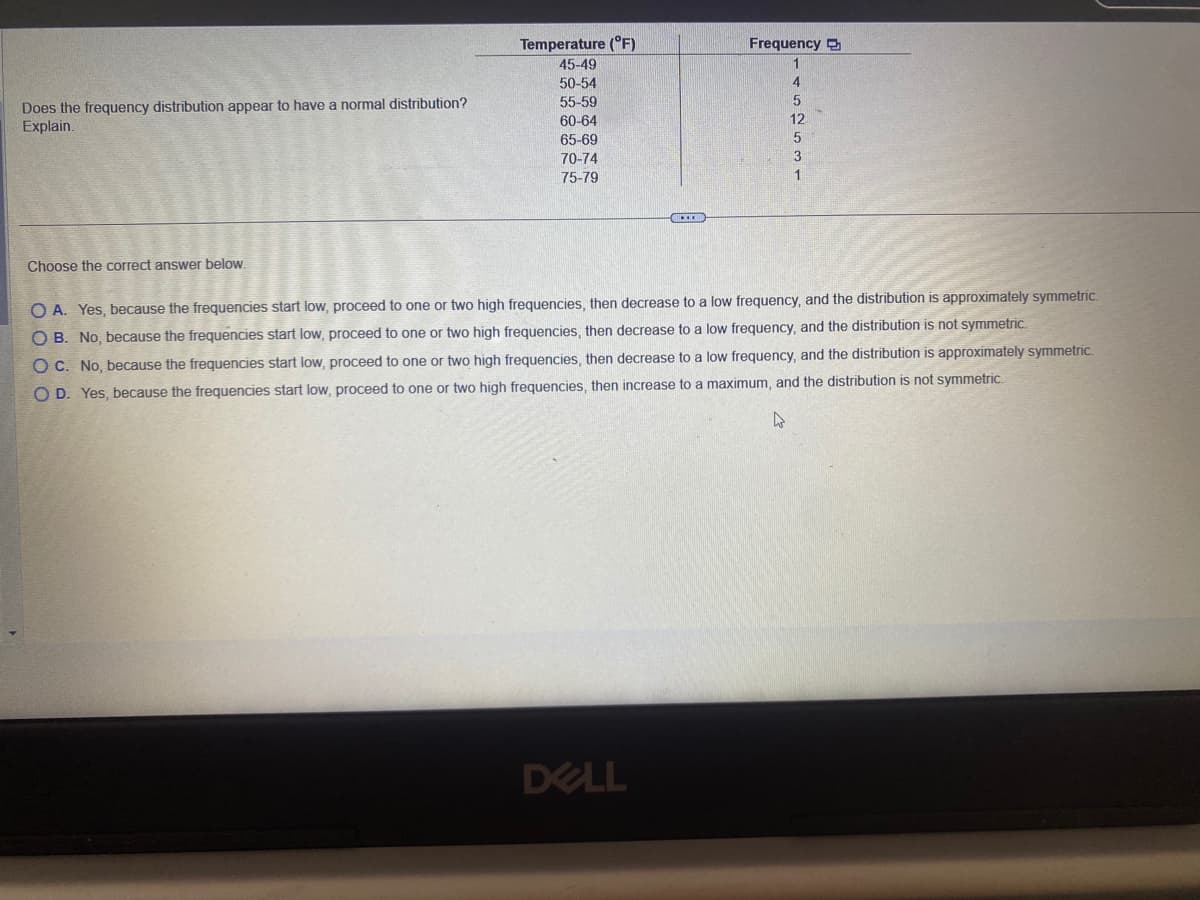Does the frequency distribution appear to have a normal distribution? Explain. Choose the correct answer below. Temperature (°F) 45-49 50-54 55-59 60-64 65-69 70-74 75-79 Frequency 4 5 12 5 3 1 O A. Yes, because the frequencies start low, proceed to one or two high frequencies, then decrease to a low frequency, and the distribution is approximately symmetric. OB. No, because the frequencies start low, proceed to one or two high frequencies, then decrease to a low frequency, and the distribution is not symmetric. OC. No, because the frequencies start low, proceed to one or two high frequencies, then decrease to a low frequency, and the distribution is approximately symmetric. O D. Yes, because the frequencies start low, proceed to one or two high frequencies, then increase to a maximum, and the distribution is not symmetric. 4
Does the frequency distribution appear to have a normal distribution? Explain. Choose the correct answer below. Temperature (°F) 45-49 50-54 55-59 60-64 65-69 70-74 75-79 Frequency 4 5 12 5 3 1 O A. Yes, because the frequencies start low, proceed to one or two high frequencies, then decrease to a low frequency, and the distribution is approximately symmetric. OB. No, because the frequencies start low, proceed to one or two high frequencies, then decrease to a low frequency, and the distribution is not symmetric. OC. No, because the frequencies start low, proceed to one or two high frequencies, then decrease to a low frequency, and the distribution is approximately symmetric. O D. Yes, because the frequencies start low, proceed to one or two high frequencies, then increase to a maximum, and the distribution is not symmetric. 4
MATLAB: An Introduction with Applications
6th Edition
ISBN:9781119256830
Author:Amos Gilat
Publisher:Amos Gilat
Chapter1: Starting With Matlab
Section: Chapter Questions
Problem 1P
Related questions
Question
Q4

Transcribed Image Text:Does the frequency distribution appear to have a normal distribution?
Explain.
Choose the correct answer below.
Temperature (°F)
45-49
50-54
55-59
60-64
65-69
70-74
75-79
**
DELL
Frequency
4
5
12
5
3
1
O A. Yes, because the frequencies start low, proceed to one or two high frequencies, then decrease to a low frequency, and the distribution is approximately symmetric.
OB. No, because the frequencies start low, proceed to one or two high frequencies, then decrease to a low frequency, and the distribution is not symmetric.
OC. No, because the frequencies start low, proceed to one or two high frequencies, then decrease to a low frequency, and the distribution is approximately symmetric.
O D. Yes, because the frequencies start low, proceed to one or two high frequencies, then increase to a maximum, and the distribution is not symmetric.
4
Expert Solution
This question has been solved!
Explore an expertly crafted, step-by-step solution for a thorough understanding of key concepts.
This is a popular solution!
Trending now
This is a popular solution!
Step by step
Solved in 2 steps with 2 images

Recommended textbooks for you

MATLAB: An Introduction with Applications
Statistics
ISBN:
9781119256830
Author:
Amos Gilat
Publisher:
John Wiley & Sons Inc

Probability and Statistics for Engineering and th…
Statistics
ISBN:
9781305251809
Author:
Jay L. Devore
Publisher:
Cengage Learning

Statistics for The Behavioral Sciences (MindTap C…
Statistics
ISBN:
9781305504912
Author:
Frederick J Gravetter, Larry B. Wallnau
Publisher:
Cengage Learning

MATLAB: An Introduction with Applications
Statistics
ISBN:
9781119256830
Author:
Amos Gilat
Publisher:
John Wiley & Sons Inc

Probability and Statistics for Engineering and th…
Statistics
ISBN:
9781305251809
Author:
Jay L. Devore
Publisher:
Cengage Learning

Statistics for The Behavioral Sciences (MindTap C…
Statistics
ISBN:
9781305504912
Author:
Frederick J Gravetter, Larry B. Wallnau
Publisher:
Cengage Learning

Elementary Statistics: Picturing the World (7th E…
Statistics
ISBN:
9780134683416
Author:
Ron Larson, Betsy Farber
Publisher:
PEARSON

The Basic Practice of Statistics
Statistics
ISBN:
9781319042578
Author:
David S. Moore, William I. Notz, Michael A. Fligner
Publisher:
W. H. Freeman

Introduction to the Practice of Statistics
Statistics
ISBN:
9781319013387
Author:
David S. Moore, George P. McCabe, Bruce A. Craig
Publisher:
W. H. Freeman